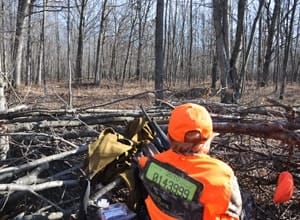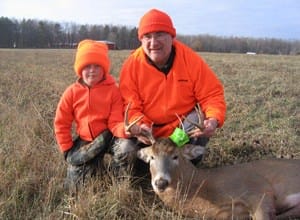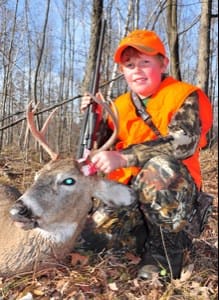
Thousands of Sandhill Cranes serenaded us as they climbed in altitude over our heads. My 12-year-old son, Andrew, and I quietly settled into our blind. The morning air was cold, but the rising sun gave hope for warmth. Knowing it could be an all-day sit, we were prepared with blankets and hand warmers.
Our blind was formed from an oak that had blown over. With the root ball at our backs and the branches gathered and stacked in front of us, it was cozy and well-concealed. The first couple of hours passed with great anticipation, but doubt began to creep in as the hours passed with no deer. The occasional rifle shot in the distance reminded us to stay focused.
A brief walk at lunch to stretch our legs and warm our bones proved fruitful. We bumped some deer and saw no other hunters. We returned to our blind with a renewed spirit. As we basked in the warm afternoon sun, I fought the urge to take a nap. Suddenly, my hazy daydream was interrupted by a hint of movement. Like vapor, a buck appeared. I nudged Andrew…
Andrew had drawn a special youth-only tag to hunt deer in Wisconsin’s Sandhill Wildlife Area. To earn this tag, youth hunters must pass a Hunter Safety Course and attend a full day of training by the Sandhill staff. The training day reaffirms hunter safety rules, hunter ethics and whitetail deer biology. This hunt is the perfect venue for introducing first time hunters to deer hunting.

As hunters and conservationists, mentoring tomorrow’s hunters should be our number one priority. Hunters are the first to conserve natural resources, but who are we training to lead future generations? The solution lies with each of us. We need to find opportunities to positively influence today’s youth and show them the doors that lead outside.
I was raised by a man who excelled in this. My brother John and I learned lessons like wildlife preservation and hunter ethics at a young age. My father, Noel Barteck, didn’t stop at teaching his sons. He’s been passing it on as a hunter safety instructor for 38 years. He’s made ripples in the waters of youth mentoring that will stretch long and far. His greatest reward has been joining in mentoring his grandsons and seeing another generation take the baton.
To create a young hunter, you first must create interest in the outdoors. Taking young children on hikes is a great way to start. Take time to look at the birds, toads and animal tracks. Keep the pace easy and the mood light-hearted. Before long, those hikes will turn into weekend camping trips or fishing outings.
Be sure to bring home any wild game you harvest. Kids will marvel at the colorful bird feathers or whiskers on the deer. Make this a question and answer time. Use it as an opportunity to teach children where food comes from. And be sure to present the animal in as close to a natural state as possible. A bloody, dirty mess will turn off a child’s interest immediately.

A good time to introduce a child to shooting sports is between the ages of five and 10. Start small and work your way up. My kids each got a BB gun for their eighth birthday, then a .22 LR at 10. Before heading to the range, you should determine your youngster’s dominant eye. Both my son and daughter are right-handed but left-eye dominant. Determining eye dominance is easy. Give your youngster something with a small opening, like a paper towel roll, and ask them to look at a distant object. It’s easier to teach the mechanics of shooting left-handed than trying to compensate for shooting with a non-dominant right eye. At six years of age, Andrew was learning to shoot a BB gun and a plastic bow left-handed. Now it’s second nature to him.
Make range time fun and safe. Bring lots of reactive targets and keep them at short distances. Many kids have enjoyed shooting tin cans. The jumping and bouncing bring laughter every time. Demonstrate safe range rules. Once they’re old enough to deer hunt, always start and end range practice with a .22. If possible, set up their .22 with the same scope or sights on the deer rifle they’ll use. This will help them become accustomed to eye relief and sight picture.
In the heat of the moment, being able to find the animal in the scope can be difficult. If they’ve shot a few thousand rounds through a .22 set up the same as their rifle, you can stack the deck for success. When it’s time to shoot the big gun, bring out a life size deer paper target to talk about shot placement and the anatomy of a making a quick, clean kill.
Make the first trip afield for big game comfortable and fun so they’ll want to go again. At age six, Andrew and I sat in a blind on a warm October evening during a doe season. He played with toys and ate snacks as we waited. When a doe appeared, I didn’t say a word and waited for him to see it. After a few minutes, he spotted her and excitedly said, “Daddy get your gun; a doe is out there.” He covered his ears with his eyes wide open as I dropped the doe with a well-aimed shot. His excited reaction left no doubt I had a future hunter on my hands.

Now, six years later, Andrew was the one moving his rifle slowly into position. I was crouched beside him holding his shooting stick, quietly coaching him through the shot.
“Can you see him in the scope?” I asked.
“Yeah Dad, I see him,” he replied.
“Okay, hold the cross hairs right on his shoulder and start squeezing that trigger,” I reminded him.
The buck, now only 40 yards away, was oblivious to our presence. I listened to Andrew pause in his breathing, and the shot rang out. The buck wobbled as he left our sight. The jubilee that followed will forever be one of the best moments of my life. Being with my son when he shot his first buck was an amazing feeling. God built me to be the spiritual leader of my home, and I strongly believe teaching these lessons in the outdoors are part of the journey. As we admired and gave thanks for Andrew’s beautiful seven point buck, I was reminded of 30 years earlier when I killed my first deer with my dad. Dad passed it on to me, and I’m passing it on to my children. It’s my hope that you will pass it on too.







